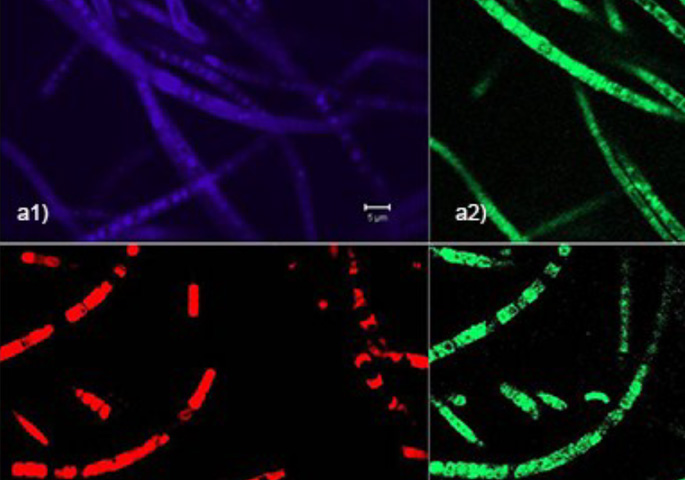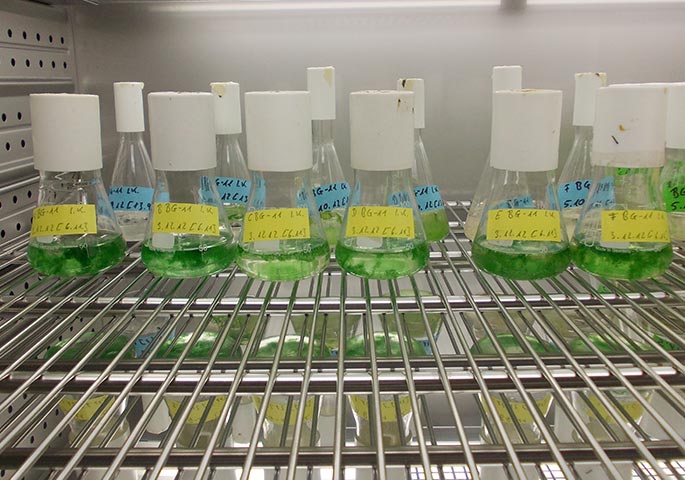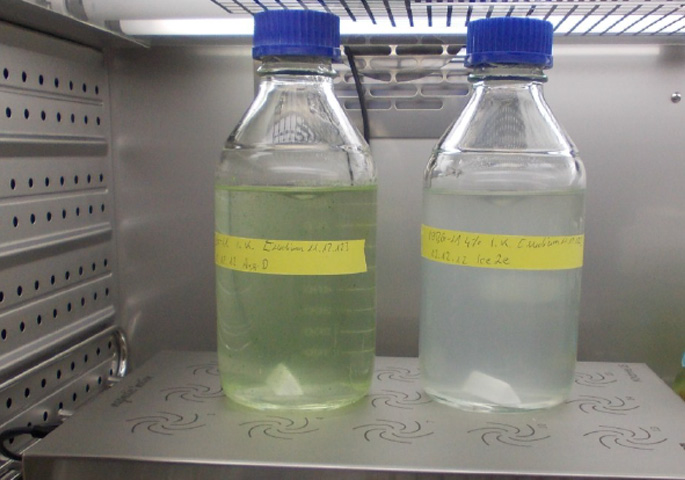Requirements:
- Climate chamber with daylight illumination for cultivating the reference stock of thermophilic cyanobacteria
- Growth experiments with selected cultures
- Adjustable temperature and illumination
- Reproducible results
- Absolute stable parameters within a series of experiments
BINDER solution:
- BINDER KBW series — climate chamber with daylight illumination
- Constant and gentle circulation of air through large-surface side walls even under a full load
- Homogeneous climate conditions throughout all specimens
- Flexible positioning and fully removeable illumination cassettes
- 2 variable positioned illumination cassettes with 5 daylight illumination, tubes, each, in steps switchable
- The patented illumination system assures an unique homogeneous light distribution
- Reliable testing independent of ambient conditions
- Cyanobacteria — Origin of modern life and hope for the future

Most people associate the word "bacterium" with illness. In fact, human life would not exist without bacteria. The beginnings of cyanobacteria can thus be equated with the development of higher forms of life on Earth. More than 3 billion years ago, cyanobacteria were the first organisms to carry out oxygenic photosynthesis. In this conversion process, molecular oxygen is produced as a waste product. Photosynthetic mass production of oxygen eventually lead to the critical transformation of an atmosphere initially void of oxygen to an atmosphere with oxygen, which made life on Earth possible in the first place.
Microorganisms against green house gases und global warming
In the coming decades, the greatest challenge for man and nature will be combatting the effects of greenhouse gases and global warming. At the University of Duisburg-Essen, therefore, researchers are studying the unique life form of thermophilic cyanobacteria in the field of aquatic biotechnology. In different types of photobioreactors, the world's most diverse microorganisms that use light to produce their own energy are cultivated in this artificial environment.
There is a great need for suitable organisms for these reactors. The project at the University of Duisburg-Essen is focused in the search and characterization of these organisms. The organisms must be suitable for a pilot plant which is operated with seawater and located in desertic environments. Because the microorganisms must be able to thrive in
seawater and in extreme heat apart from the photosynthesis, the choice was consequently made for thermophilic cyanobacteria. The optimum temperature of the bacteria also called "blue-green algae" lies between 40 °C – 75 °C.
High temperature accuracy
When researching cyanobacteria, constant light and temperature conditions are of utmost importance. Therefore, the
research group at the University of Duisburg-Essen has decided to use a BINDER climate chamber of the KBW series with daylight lamps and a storage capacity of 720 liters. The most important features of the climate chamber are the
high temperature accuracy of the unit and the unique homogeneous light distribution throughout the usable space.
This is of particular importance when working with phototrophic thermophilic microorganisms. In addition to cultivating the reference stock of thermophilic cyanobacteria, various growth experiments are carried out.
Homogeneous climate conditions
The experiments are carried out using selected cultures under varying temperature conditions, exposure cycles and luminous intensity. In addition to the homogeneous climate conditions on all samples, the scientists also appreciate that reproducible results are guaranteed due to the chamber preheating technology. "In aquatic biotechnology, processes must be reproducible," explains Inga Vanessa Kirstein, lead project scientist at the University of Duisburg-Essen. "In other words, experiments are run in multiple determinations on the one hand and on the other, experiments can be repeated. Within a series of experiments, it is imperative that the parameters are stable and that is a give with BINDER chambers 100 %."
Characterization of bacteria
Since the early 1980s, the focus of the research group lead by Prof. Dr. Wolfgang Sand has included topics such as biological leaching, biogenic concrete and metal corrosion. The focus is mainly on the microbiology of the iron, manganese, and sulfur cycles, which include moderate and extreme acidophilic iron and sulfur compound-oxidizing species (e.g. of the genera Acidithiobacillus and Leptospirillum). The scientific focus of the AQUATIC BIOTECHNOLOGY research group currently includes studies on biocorrosion on steel structures (technical applications), bioflotation and surface colonization of sulfide minerals, as well as physiological work in characterizing relevant bacterial strains. In addition, researchers are pressing forward with the development of sealing systems for (waste) water transport pipelines with special emphasis on microbial colonization and degradability.


Advantages:
- Homogeneous light distribution
- Natural growth conditions
- Temperature & light in one unit
Areas of application:
- Plant- / Insect Growth
- Cosmetics Industry
- Packaging Industry
- Clinics / University Hospitals